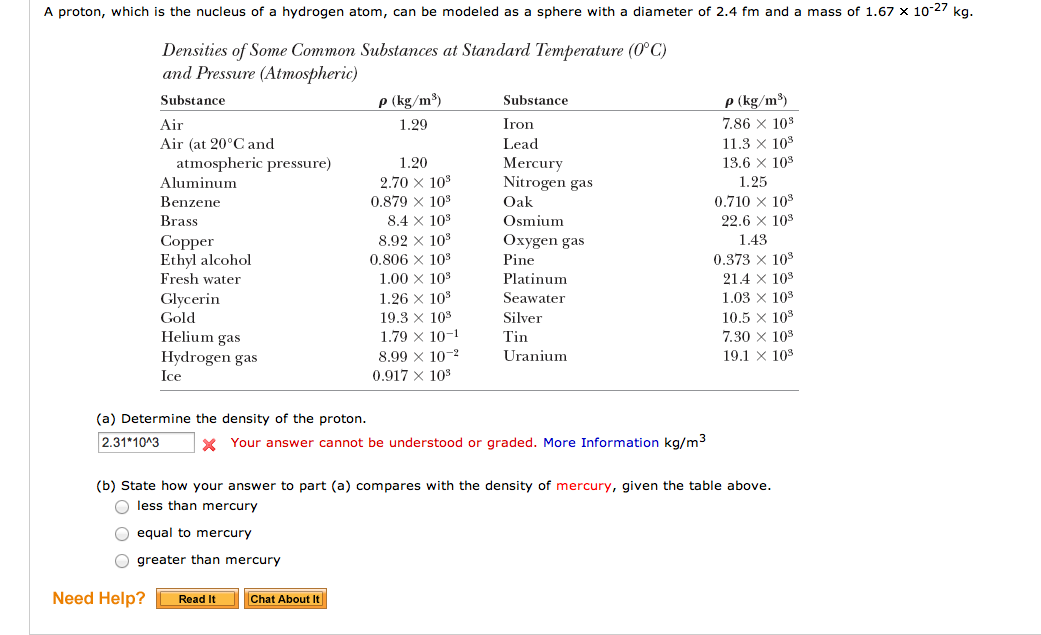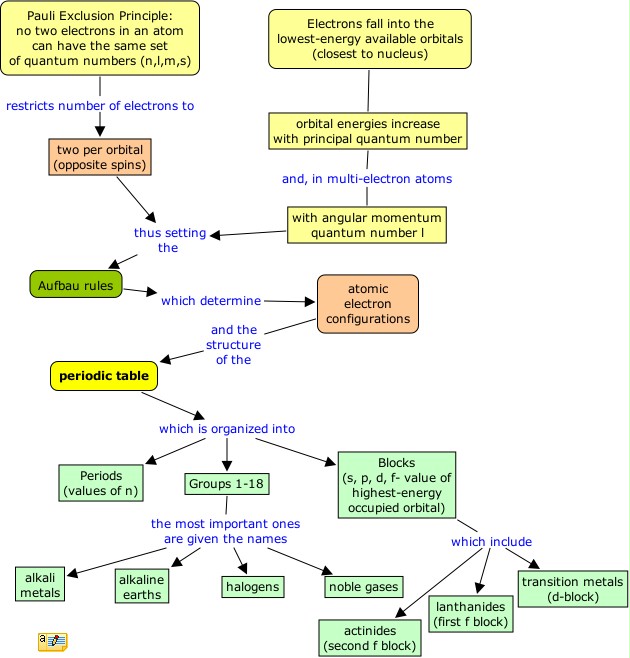Mass Of Hydrogen Atom In Kg
- Mass Of The Hydrogen Atom In Kg
- Mass Of Hydrogen Atom In Grams
- Mass Of Hydrogen Atom In Kg Chart
- Average Mass Of Hydrogen Atom In Kg
Hydrogen weighs 0.000082 gram per cubic centimeter or 0.082 kilogram per cubic meter, i.e. Density of hydrogen is equal to 0.082 kg/m³; at 0°C (32°F or 273.15K) at standard atmospheric pressure. In Imperial or US customary measurement system, the density is equal to 0.0051 pound per cubic foot lb/ft³, or 0.0000474 ounce per cubic inch oz.
'The Sun, with all the planets revolving around it, and depending on it, can still ripen a bunch of grapes as though it had nothing else in the Universe to do.' ~ Galileo Mass: 1.989x1030 kg Radius: 695,000 km (equator) Mean Density: 1.410 gm/cm3 Rotation Period: 25 - 36 days Escape Velocity: 618.02 km/sec Luminosity: 3.839 x 1026 watts Magnitude (Vo): -26.8 Surface Temp: 5,780 K (mean) Age: 4.5 billion years In the core of the Sun hydrogen is being converted into helium. This is called nuclear fusion. It takes four hydrogen atoms to fuse into each helium atom. During the process some of the mass is converted into energy. Mass of 4 H atoms: 4.03130 AMU Mass of 1 He atom: 4.00268 AMU 1 Atomic Mass Unit (AMU) equals 1.67x10-27kgs The difference between the mass of 4 H atoms and 1 He atom is 0.02862 AMU which is only 0.71% of the original mass. This small fraction of the mass is converted into energy. If 4 grams (1/8 ounce) of H are converted to He, only 2.8x10-3 grams of the mass is converted to energy: How much energy is generated from converting such a tiny amount of mass? We can calculate by using Einstein's famous formula. E = mc2 E = (2.8x10-3 grams) x c2 E = (2.8x10-6 kgs) x (3x108m/sec)2 E = 2.6x1011 joules Enough energy to keep a 60-watt light bulb shining for over 100 years! The Sun has different layers with different properties, these layers are composed of material that is about 75% hydrogen and 25% helium by mass. Simply put, the Sun is a great ball of gas, hot enough to glow in every tier. In the very innermost part of the Sun, called its core, the temperature is about 15 million Kelvins, the density is 150 times that of water, and the pressure is over 200 billion times greater than atmospheric pressure here on Earth. This heavy, sweltering place is where the Sun's energy is produced via a process known as thermonuclear fusion. While fusion is difficult to mimic on Earth, the core of the Sun and other stars is a perfect environment for it. Here, the temperatures are high enough for hydrogen nuclei to smash together and form helium nuclei, releasing tremendous amounts of energy in various forms. Energy produced in the form of light keeps bouncing around inside the Sun, as though the Sun were made entirely of mirrors. A particle of light can take more than 30,000 years to reach the surface and escape! Energy in the form of small particles called neutrinos, however, can travel directly out of the Sun and into the Solar System. Neutrino observatories on Earth measure the continual wash of these tiny, fast-moving particles. The apparent visual magnitude of the Sun is -26.8, making it appear about 10 billion (10,000,000,000) times as bright as the next brightest star, Sirius. The absolute magnitude of the Sun, the magnitude it would have at a distance of 10 parsec or 32.6 light years, is +4.8. Among the brightest stars we can see with the naked eye, there is only one, alpha Centauri, with a comparable absolute magnitude to the Sun. Most of the rest are intrinsically far brighter. Light takes about 500 seconds (8 1/3 minutes) to travel from the Sun to the Earth. The average distance to the Earth from the center of the Sun is about 149,000,000 km, or 93,000,000 miles; a distance known as an astronomical unit (AU). There are over 63,000 AU in 1 light year. 1 AU is about 0.000016 light year. The nearest star, alpha Centauri, is 4.3 light years distant, or about 280,000 AU. Activity on the solar surface, photo by Brad Snowder. |
- How to Convert Atomic Mass Unit to Kilogram. 1 u = 1.6605402E-27 kg 1 kg = 6.752E+26 u. Example: convert 15 u to kg: 15 u = 15 × 1.6605402E-27 kg = 2.4908103E-26 kg.
- Hydrogen weighs 0.000082 gram per cubic centimeter or 0.082 kilogram per cubic meter, i.e. Density of hydrogen is equal to 0.082 kg/m³; at 0°C (32°F or 273.15K) at standard atmospheric pressure.
- Hydron is the general name for the hydrogen nucleus, to be used without regard to the hydrogen nuclear mass (either for hydrogen in its natural abundance or where it is not desired to distinguish between the isotopes). It is a member of atomic nucleus, a monoatomic hydrogen, a monoatomic monocation and a monovalent inorganic cation.
- A proton is one of the subatomic particles that make up matter. In the universe, protons are abundant, making up about half of all visible matter.It has a positive electric charge (+1e) and a rest mass equal to 1.67262 × 10 −27 kg (938.272 MeV/c 2)— marginally lighter than that of the neutron but nearly 1836 times greater than that of the electron.

So then, why isn't the atomic mass of Hydrogen exactly 1?
Mass Of The Hydrogen Atom In Kg
If you check a periodic table, you'll see that Hydrogen actually has a mass of 1.00794. If hydrogen is the lightest of all substances, then why not give it a mass of exactly 1 on our relative mass scale?


There are three reasons:
- First, atoms have isotopes, and these isotopes do not all have the same mass. The mass of the atoms in nature - what we use as the atomic mass - is a weighted average of all these different isotopes.
Here are the exact atomic masses and abundances of an atom with two imaginary stable isotopes.
To 4 significant digits, what would be the calculated atomic mass of naturally occurring X? |

- The second reason is historical. Once upon a time, way back before 1961, there actually were two sets of atomic masses (though everybody called them atomic weights then). One scale was used by physicists; the other by chemists. Both were based on weights compared to Oxygen, rather than Hydrogen. Oxygen was used because it combines with a lot of things to form oxides. This made it a better choice as a standard because of the ease of chemical analysis. Oxygen was set to have an atomic mass of 16, which was just about 16 times as heavy as Hydrogen being 1. Unfortunately, Chemists picked naturally occurring Oxygen, which is a mixture of isotopes of Oxygen-16, Oxygen-17, and Oxygen-18. After all when you made an oxide of an element you would do so in naturally occurring oxygen. Physicists picked the pure isotope Oxygen-16, because they tended to make their measurements on the basis of mass spectrometry.
Though the ratio of any two atom's masses was the same on either scale, it was horribly confusing, so in 1961, a compromise was reached. Instead of using either Hydrogen, or Oxygen as the standard, the isotope of Carbon with 6 protons and 6 neutrons in its nucleus (Carbon-12) was given a mass of exactly 12. It was a good choice, since it was in between the two previously used standards, and meant that nothing had to change too much.
| Which of the following statements is correct? |
Mass Of Hydrogen Atom In Grams

Mass Of Hydrogen Atom In Kg Chart
- The third reason is the most important of all. If a hydrogen atom has only one proton, and carbon-12 has 6 protons and 6 neutrons to make up its mass of twelve, why isn't the mass of hydrogen 1/12 of that of carbon-12?
Mass of 1 hydrogen atom Mass of sub-atomic particles Mass of 1 carbon-12 atom 1.00794 6 protons = 6 x 1.007277 6.043662 6 neutrons = 6 x 1.008665 6.051990 6 electrons = 6 x 0.000548 0.003288 Total 12.098940 12.0 exactly If you think about it, Hydrogen at 1.00794 is more than 1/12 of the weight of carbon-12 (as you can see from the above table, if you multiply 12 times the mass of a single hydrogen atom it comes to more than 12). The reason for this effect is nuclear binding energy. After all, the protons in the nucleus are all positive, and so the nucleus should just repel itself apart. It doesn't of course, so something must be 'binding' it together. This nuclear binding energy makes the mass of all atoms (except hydrogen-1, which only has 1 proton) slightly lighter that what you'd get by adding up the mass of the sub-atomic particles. Einstein's famous equation E = mc2 shows us that we can get the necessary binding energy from the mass of the sub-atomic particles. So the mass of any multi-nucleon atom is less than the sum of the weights of its separated parts. Its this change in mass when the nucleus changes size that is the source of the enormous amount of energy in nuclear reactions.
So we could have set hydrogen to be exactly 1, but then we'd have had to really revise the atomic weight table back in 1961. If hydrogen was assigned a mass of 1 exactly, then oxygen would have become 15.87, quite a difference from the mass chemists were using. Choosing carbon-12 as the reference standard meant the least change was necessary. Still, if you do really accurate calculations based on the old and the new scale you can see some differences. For example, on the pre-1961 atomic weight scale the molecular weight of table salt, Sodium chloride NaCl would have been 58.45. On today's scale it is 58.44. The difference is just 0.02%, so for most purposes it wouldn't matter.
Hold it! You just used the term molecular weight. Isn't that wrong? Yes, of course it is, but for Sodium chloride, we shouldn't even use the term molecular mass. Instead we should use the term 'formula mass', because Sodium Chloride really isn't a molecule of NaCl.
Average Mass Of Hydrogen Atom In Kg
Copyright © 1998 - 2008 David Dice
